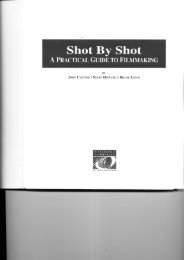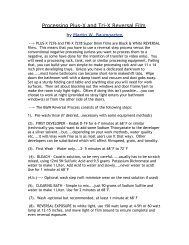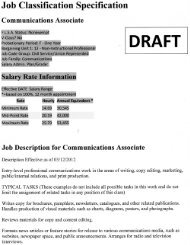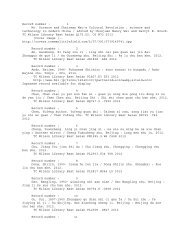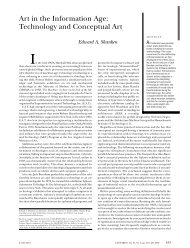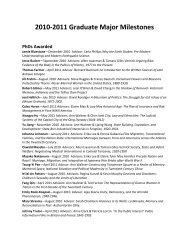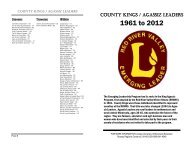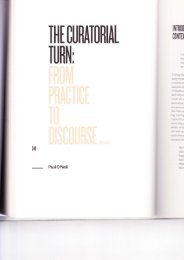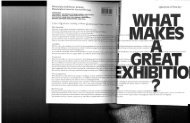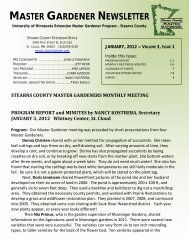Labelling and Marking Museum Objects Booklet
Labelling and Marking Museum Objects Booklet
Labelling and Marking Museum Objects Booklet
Create successful ePaper yourself
Turn your PDF publications into a flip-book with our unique Google optimized e-Paper software.
<strong>Labelling</strong> <strong>and</strong> <strong>Marking</strong><br />
<strong>Museum</strong> <strong>Objects</strong> <strong>Booklet</strong>
Collections Trust<br />
The Collections Trust is the UK’s independent organisation for collections.<br />
It sets professional Collections Management st<strong>and</strong>ards, <strong>and</strong> provides advice,<br />
support <strong>and</strong> training to help people meet them. Its aim is to connect people <strong>and</strong><br />
collections, making collections accessible to everyone, now <strong>and</strong> in the future.<br />
The Collections Trust manages the award-winning Collections Link<br />
advisory service <strong>and</strong> publishes SPECTRUM, the UK <strong>and</strong> international<br />
st<strong>and</strong>ard for Collections Management.<br />
www.collectionstrust.org.uk<br />
© Collections Trust, 2008. All Rights Reserved.
Contents<br />
<strong>Labelling</strong> <strong>and</strong> <strong>Marking</strong> <strong>Museum</strong> <strong>Objects</strong> .................................................... 1<br />
Why do it?................................................................................................................................................. 1<br />
When is it done <strong>and</strong> who does it? .......................................................................................................... 1<br />
Health <strong>and</strong> Safety ..................................................................................................................................... 2<br />
Materials to avoid .................................................................................................................................... 2<br />
Security marking ...................................................................................................................................... 3<br />
Positioning of labels <strong>and</strong> marks ................................................................. 4<br />
Basic Techniques ........................................................................................ 5<br />
1. Writing on the object ........................................................................................................................... 5<br />
2. Sticking a label on the object ............................................................................................................. 6<br />
3. Sewn on label ....................................................................................................................................... 7<br />
4. Immersible label (for specimen preserved in fluid) ......................................................................... 8<br />
5. Water immersible label (for object stored in water) ......................................................................... 8<br />
6. Label on pin (for pinned biological specimen) ................................................................................. 8<br />
7. Loose label (for small objects such as coins) ................................................................................. 9<br />
8. Tie-on label ........................................................................................................................................... 9<br />
9. Duplicated pencil mark ..................................................................................................................... 10<br />
10. Number applied with paint .............................................................................................................. 10<br />
11. <strong>Marking</strong> packaging or support ....................................................................................................... 10<br />
12. Mixing the varnish ........................................................................................................................... 11<br />
Assembling a labelling <strong>and</strong> marking kit ................................................... 12<br />
Materials ................................................................................................................................................. 13
<strong>Labelling</strong> <strong>and</strong> <strong>Marking</strong> <strong>Museum</strong> <strong>Objects</strong><br />
SPECTRUM Procedure Acquisition<br />
These labelling <strong>and</strong> marking guidelines have been developed by the Collections Trust with the help<br />
of Vivien Chapman at the National Conservation Centre, National <strong>Museum</strong>s Liverpool (NML).<br />
Why do it?<br />
<strong>Labelling</strong> <strong>and</strong> marking is part of the SPECTRUM procedure Acquisition, a SPECTRUM<br />
Primary Procedure, required to be in place for <strong>Museum</strong> Accreditation (see below). The<br />
Accreditation St<strong>and</strong>ard says that:<br />
'<strong>Marking</strong> <strong>and</strong> <strong>Labelling</strong>: Each accessioned item, or group of items, must be marked <strong>and</strong>/or<br />
labelled with its/their unique identity number in a way that is as permanent as possible<br />
without damaging the item.'<br />
Every item in a museum collection must carry its identity number at all times, so that it<br />
can be linked to the information a museum holds about the object. If this bond between the<br />
object <strong>and</strong> its documentation is broken, the consequences may be serious. At best, time will<br />
be wasted because of the need to track down documentation <strong>and</strong> re-establish the link. At<br />
worst, the object will lose its provenance <strong>and</strong> other associated information for all time.<br />
Note that the marking an object is not intended to act as a security device in the case of theft<br />
of the object.<br />
The Minimum St<strong>and</strong>ard for labelling <strong>and</strong> marking under Acquisition, states that museums should:<br />
Ensure that a unique number is assigned to, <strong>and</strong> physically associated with all objects.<br />
When is it done <strong>and</strong> who does it?<br />
<strong>Marking</strong> <strong>and</strong>/or labelling an object should be done as part of the accessioning process. Items<br />
on loan or not yet accepted into the collection should not be marked. Items which do not<br />
belong the museum, such as loans or potential donations should be labelled.<br />
The preference should normally be to physically mark objects: however in some cases this<br />
may not be possible. These guidelines will help you label <strong>and</strong> mark the items in your<br />
collections in ways which are:<br />
Secure - The chances of accidental removal of the label or mark from the object<br />
must be extremely low;<br />
Reversible - It should be possible for a label or mark to be removed intentionally<br />
from an object, even after 50-100 years with as little trace as possible;<br />
Safe for the object - Neither the materials applied to the object nor the method by<br />
which they are applied should risk significant damage to the object;<br />
Discreet but visible - The recommended methods should not spoil the appearance<br />
of the object, nor obscure important detail. However, the number should be visible<br />
enough to reduce the need to h<strong>and</strong>le the object;<br />
Convenient <strong>and</strong> safe for staff <strong>and</strong> volunteers - Materials should be easily available<br />
in small quantities at a reasonable price, <strong>and</strong> should not pose significant risks to health if<br />
used in accordance with the guidelines recommended by a local CoSHH risk assessment.<br />
1
Health <strong>and</strong> Safety<br />
Before using any technique, assess the health <strong>and</strong> safety risks associated with it. Under the<br />
CoSHH legislation (Control of Substances Hazardous to Health), it is the responsibility of each<br />
museum to carry out such an assessment, <strong>and</strong> to develop internal guidelines to ensure safe working<br />
practices. Guidance is available from the Health & Safety Executive, from introductory leaflets on<br />
CoSHH published by HMSO <strong>and</strong> from product information sheets available from suppliers.<br />
As with any work involving the use of potentially hazardous substances consider, for example,<br />
the need for:<br />
Washing of h<strong>and</strong>s before <strong>and</strong> after a labelling <strong>and</strong> marking session;<br />
Adequate ventilation;<br />
Disposal of waste;<br />
Cleaning <strong>and</strong> care of equipment;<br />
H<strong>and</strong> <strong>and</strong> eye protection;<br />
Safe storage of materials <strong>and</strong> safe methods of decanting them;<br />
A ban on food, drink <strong>and</strong> smoking from the work area.<br />
Particular care is needed when working with acetone - a highly flammable solvent.<br />
For more Health <strong>and</strong> Safety advice <strong>and</strong> help with Health <strong>and</strong> Safety assessments go to<br />
www.coshh-essentials.org.uk<br />
The following are Health <strong>and</strong> Safety assessments produced by National <strong>Museum</strong>s Liverpool<br />
from the CoSHH essentials website:<br />
Paraloid B67 20% in white spirit<br />
Paraloid B72 20% in acetone<br />
The following are relevant COSHH Essentials guidelines:<br />
General advice<br />
General ventilation<br />
Selection of personal protective equipment<br />
Materials to avoid<br />
It is tempting, for the sake of cheapness <strong>and</strong> convenience, to substitute non archive alternatives<br />
such as Tippex TM or clear nail varnish for white ink <strong>and</strong> Paraloid B72. These materials are<br />
unsuitable, <strong>and</strong> should never be used on museum objects for the following reasons:<br />
Tippex<br />
2<br />
TM dries to form an inflexible surface layer subject to cracking <strong>and</strong> detachment.<br />
It is not designed for long-term stability, <strong>and</strong> may discolour <strong>and</strong> deteriorate with age.<br />
If it comes into direct contact with the surface of an object, it can be extremely difficult<br />
to remove <strong>and</strong> leaves an unsightly white residue; Tippex TM has a tendency to dry out<br />
<strong>and</strong> thicken in its container, making it difficult to apply smoothly, <strong>and</strong> resulting in an<br />
obtrusive <strong>and</strong> unsightly mark;<br />
Different manufacturers produce clear nail varnishes to a variety of formulations.<br />
They are not designed for long-term stability, <strong>and</strong> their ageing properties are unknown.<br />
However, in common with many other polymers, they are likely to cross-link with age,<br />
resulting in embrittlement <strong>and</strong> discolouration, <strong>and</strong> possible loss of primary information;<br />
Nail varnish remover is not a substitute for laboratory-grade acetone. It is a different<br />
solvent called amyl acetate.
Remember that any chemical substance, unless it has been developed or tested within the<br />
museum profession so that its properties are known, may have adverse effects on museum<br />
objects. Always check with a conservator before proceeding.<br />
Also remember that even commonplace materials like Tippex TM can contain harmful chemicals,<br />
<strong>and</strong> bear hazard warning symbols. Treat them with the same care you would any other chemical,<br />
<strong>and</strong> observe CoSHH <strong>and</strong> H&S regulations for their use, storage <strong>and</strong> disposal.<br />
Security marking<br />
Ordinary UV security marker pens or Smartwater TM (an aqueous suspension of marker<br />
chemicals that fluoresce under UV light) can be applied to a Paraloid B72 base coat, as<br />
described in Basic Technique 1: Writing on the Object. This makes them easier to remove,<br />
ensuring reversibility, although it correspondingly lessens the degree of security protection.<br />
Alternatively, an object could be marked on its pedestal, frame or mount (see Basic Technique 11:<br />
<strong>Marking</strong> packaging or support, bearing in mind that these can become separated from the object itself).<br />
3
Positioning of labels <strong>and</strong> marks<br />
Avoid physically unstable surfaces. Also avoid placing labels or marks across a line<br />
of weakness or fracture;<br />
Choose a position so that the number is unlikely to be visible when the object is on<br />
display but is accessible in store;<br />
Avoid decoration <strong>and</strong> painted/varnished/pigmented/waxed areas;<br />
Avoid surfaces where the mark is likely to be at risk from abrasion, such as surfaces<br />
on which it normally rests, or where touched during h<strong>and</strong>ling;<br />
Mark all detachable parts of an object (using suffixes to the Object number);<br />
Locate the number so that the h<strong>and</strong>ling necessary to read it is minimised (consider<br />
marking the packaging or adding an extra tie-on label as well);<br />
With composite objects, mark the part on which the most secure method can be used;<br />
Where duplicate marks are made these should be in different positions on the object<br />
(bearing in mind, of course, the other principles listed above).<br />
For suggestions on choosing a technique <strong>and</strong> where to mark different types of object see the<br />
NML's guidelines on <strong>Marking</strong> <strong>and</strong> <strong>Labelling</strong> Methods <strong>and</strong> Positions.<br />
4
Basic Techniques<br />
This advice is based on guidelines provided by the NML<br />
1. Writing on the object<br />
Barrier coat<br />
Paraloid (acrylic polymers)<br />
B72 poly (ethyl methacrylate/methylacrylate)<br />
B72 20% in acetone is used as a barrier coat on the object. B72 has the best ageing<br />
characteristics of any barrier coating, it doesn't change colour <strong>and</strong> stays soluble in solvents. It<br />
doesn't dissolve in white spirit. Acetone is quick drying. It may damage some types of objects<br />
Top coat<br />
Paraloid (acrylic polymers)<br />
B67 poly isobutyl methacrylate<br />
B67 20% in white spirit is used as a top coat. B67 also has good ageing characteristics but<br />
yellows a little in time. It is used dissolved in white spirit to reduce the risk of the barrier coat<br />
of B72 being dissolved.<br />
Materials<br />
Tools<br />
Paraloid B72 20% solution in acetone<br />
Paraloid B67 20% solution in white spirit<br />
Permanent black markers or Rotring pens <strong>and</strong> permanent black ink<br />
Permanent white markers<br />
Acetone<br />
Artists brushes or brush in cap containers<br />
Paper towels<br />
Cotton wool swabs<br />
Tool Pros Cons<br />
Metal pen eg Mapping pen or<br />
Rotring pen or Rotring <strong>and</strong><br />
Indian ink<br />
Traditional <strong>and</strong> excellent in<br />
experienced h<strong>and</strong>s<br />
May scratch <strong>and</strong> blob<br />
Brush Kindest to most surfaces Hardest to control<br />
Felt tip or roller ball pen with<br />
pigment ink<br />
Easiest to control Ink may not be acid free or<br />
permanent<br />
5
Method<br />
1. Read the Health <strong>and</strong> Safety data sheets <strong>and</strong> check that you are working in a well<br />
ventilated area.<br />
2. Select a clean area on the object's surface.<br />
3. Support the object if necessary so that you will be able to leave it to dry after marking.<br />
4. Fill the cap brush or an artist’s brush with the Paraloid B72 solution but do not<br />
overload it to avoid drips.<br />
5. For non-porous surfaces: with one steady movement first move the brush in one<br />
direction to make a mark only slightly larger than the size of the number to be applied.<br />
Then stroke again in the opposite direction to use the solution on the other side of the<br />
brush. Then leave it to dry. Some people find it easier to apply single brush strokes.<br />
6. For porous surfaces it is important to build up enough lacquer to prevent the ink<br />
penetrating the surface. Apply at least three coats of B72, allowing it to dry before<br />
applying the next coat. Enough lacquer has been applied when it dries to a fairly<br />
consistent smooth dull sheen. Hint: try this out on a similar trial surface or even paper<br />
first then see if you can remove the number or if the ink has penetrated the surface.<br />
7. The ink should be applied in quite thick strokes with a pen appropriate to the size of the<br />
number you want to write. Leave it to set for a minute before applying a top layer of the<br />
Paraloid B67. If the ink is applied too thinly it may be damaged by the top layer of B67.<br />
8. Only one layer of B67 should be necessary, spread lightly over the surface to avoid<br />
smudging of the ink below. You can add additional layers after the first is dry to give<br />
added protection against the number being worn away.<br />
9. If you make a mistake wipe it off with a swab soaked in acetone.<br />
2. Sticking a label on the object<br />
This advice is based on guidelines provided by the NML<br />
This method can be used on many types of object but do not use on surfaces that are<br />
crumbly, flaky or hairy.<br />
Materials<br />
Use Paraloid B72, starch paste or SCMC (sodium carboxy methyl cellulose). Do not<br />
use self adhesive labels or tapes as they always deteriorate. For example, they drop<br />
off, refuse to come off <strong>and</strong> / or stain the object<br />
Consider printing the number using a laser printer or photocopier (both pigment<br />
based) onto acid free paper<br />
For varnished surfaces use starch paste<br />
For plastics use dry starch paste or SCMC<br />
Method<br />
1) Write or print the number on a small strip of acid free paper.<br />
2) Apply the adhesive to the label.<br />
3) Press the label onto the object, sufficiently firmly that it moulds itself to the object's contours.<br />
6
3. Sewn on label<br />
This advice is based on guidelines provided by the NML<br />
Materials<br />
Tyvek<br />
Pros:<br />
Cons:<br />
Tyvek (spun bonded polyolefin)<br />
Permanent markers or Rotring pens <strong>and</strong> permanent black ink<br />
Washed or unbleached cotton tape in various widths (to wash cotton tape soak it very hot water)<br />
Tie on tags<br />
Fine cotton or polyester thread<br />
Water resistant;<br />
Cheap to buy as a sheet <strong>and</strong> cut to size;<br />
Available in a range of weights. Soft weights are more sympathetic to soft, fragile objects;<br />
Smoother to write on than cotton tape for textiles <strong>and</strong> do not need hemming.<br />
Not all pens write on it. Some inks float off on immersion in water, so test;<br />
Risk of static charge which could attract particles from the object surface eg pigment.<br />
Method<br />
1) Assess the object <strong>and</strong> decide whether to sew on a label, attach a tie on label, or make<br />
a special tag. If you are going to sew on a label it must be possible to stitch into the<br />
textile without causing damage. Tie on labels should be attached through a buttonhole,<br />
or similar, so that the fabric is not damaged.<br />
2) Choose a location. Bear in mind whether the label needs to be visible when the textile<br />
is in storage. If the textile is going to be rolled it may be worth marking a long cotton<br />
tape with the same number <strong>and</strong> tying it round the rolled textile.<br />
3) Choose a tape width or label size appropriate to the object size.<br />
4) Write the label neatly. This is easier with a marker.<br />
5) For a st<strong>and</strong>ard flat cotton tape sewn-in label cut the tape approximately 5mm longer<br />
at each end than the finished length of the label, Turn under the raw ends <strong>and</strong> stitch<br />
in place with several long stitches at each end in a fine thread, preferable one that<br />
matches the textile not the label. The procedure for a sewn-in Tyvek label is the<br />
same, except no turnings are needed.<br />
6) Tape <strong>and</strong> Tyvek can also be used to make looped labels sewn to the textile at one<br />
end only. This is particularly suitable for flat textiles with a hemmed edge. The loop<br />
can be arranged so that the number can be seen with the textile flat in store, but<br />
tucked beneath for display. The stitching can be concealed in the hem so that it<br />
cannot be seen from the right side.<br />
7) Special Tyvek tags are used for fragile textiles, where a stitched label or a tie-on tag<br />
would cause damage. The number is written on a small piece of Tyvek <strong>and</strong> a fine<br />
needle is used with a length of fine polyester thread which is passed through the<br />
Tyvek <strong>and</strong> through an existing hole in the textile or between the threads from which<br />
it is woven. The ends of the thread are then knotted. This lightweight label puts little<br />
strain on the textile.<br />
7
4. Immersible label (for specimen preserved in fluid)<br />
This method is used for specimens preserved in fluid:<br />
1. Examine the object to check if the method is appropriate. If in doubt, consult a conservator.<br />
2. Write the number on an Aquascribe label or strip of Tyvek, using a pencil or a<br />
drawing ink <strong>and</strong> drawing pen.<br />
3. If using ink, allow it to dry for 24 hours. Also, check the ink for survival in fluid to be used.<br />
4. Place label in fluid with specimen <strong>and</strong> seal.<br />
5. Mark the packaging/container as well (see Basic Technique 11: <strong>Marking</strong> packaging or support).<br />
5. Water immersible label (for object stored in water)<br />
This method is used for objects stored in water, typically waterlogged glass or organic materials<br />
from terrestrial archaeological sites, <strong>and</strong> most categories of finds from maritime sites.<br />
1. Examine the object to check if the method is appropriate. If in doubt, consult a conservator;<br />
2. Write the number on a Tyvek label, using a black waterproof ink marker. Avoid pencil<br />
as it becomes illegible over time.<br />
3. Allow ink to dry for 24 hours. Also, check the ink for survival in water.<br />
4. Place label in container with object, <strong>and</strong> seal. Labels may be tied to larger objects<br />
using synthetic materials such as terylene or polypropylene twine, or plastic garden<br />
ties (which can be easily re-used).<br />
5. When labelling any type of archaeological artefact, always refer to the UKIC publications,<br />
First Aid for Finds <strong>and</strong> First Aid for Marine Finds. If in doubt, consult a specialist<br />
archaeological conservator or finds officer.<br />
6. Label on pin (for pinned biological specimen)<br />
This method is used for pinned biological specimens:<br />
1. Examine the object to check if the method is appropriate. If in doubt, consult a conservator.<br />
2. Write the object number on a small strip of acid-free paper or Tyvek using a suitable<br />
drawing ink <strong>and</strong> drawing pen.<br />
3. Stick the pin on which the specimen is mounted through this label, making sure that<br />
the hole is not too close to the edge <strong>and</strong> that the number can be read without<br />
disturbing the specimen.<br />
8
7. Loose label (for small objects such as coins)<br />
Some objects, such as coins, are too small <strong>and</strong> detailed to be marked, nor is it easy to tie a<br />
label onto them. The only option is to use a loose label:<br />
1. Examine the object to check if the method is appropriate. If in doubt, consult a conservator.<br />
2. Write the object number on an acid-free paper or Tyvek label using a suitable<br />
drawing ink <strong>and</strong> drawing pen. Put it underneath the object in its storage tray.<br />
3. Take a photograph of the object, <strong>and</strong> mark the object number on the rear border of<br />
the print using a suitable drawing ink <strong>and</strong> drawing pen (record the weight of the<br />
object as an additional means of identification).<br />
Always keep the label with the object. When the object (<strong>and</strong> hence label) is moved, a proxy<br />
card should be put in its place.<br />
8. Tie-on label<br />
This advice is based on guidelines provided by the NML<br />
Pros:<br />
Cons:<br />
Easy to get from conservation suppliers;<br />
Easy to write on;<br />
Noticeable <strong>and</strong> easy to find;<br />
Can be written on in pencil or pen.<br />
PH (acidity) should be tested if you don't know the origin;<br />
Tyvek is slightly more difficult;<br />
Easy to remove <strong>and</strong> lose;<br />
Paper labels may fall apart in a flood;<br />
Fibres from cotton may stick to artefacts;<br />
String may be nylon not cotton <strong>and</strong> deteriorate <strong>and</strong> harm the object;<br />
Cotton string may wick oil from the object, oil may cause ink to run;<br />
Paper <strong>and</strong> cotton labels are an insect food source.<br />
Materials<br />
Use white acid free paper or card labels or Tyvek tags with tape or string.<br />
Method<br />
1. Examine the object to check if the method is appropriate. If in doubt, consult a conservator.<br />
2. Write the object number on an acid-free paper or Tyvek using a suitable drawing ink<br />
<strong>and</strong> drawing pen.<br />
3. Pass tape, string or thread (as appropriate to the object) through hole in label.<br />
4. Tie tape loosely round the 'hole', 'h<strong>and</strong>le' or 'neck' of the object using a reef knot or<br />
by looping it round <strong>and</strong> through itself.<br />
9
9. Duplicated pencil mark<br />
Paper is easily marked with a good-quality 2B pencil, which can be removed with a very<br />
soft, clean eraser or Draftclean granules (available from conservation suppliers).<br />
1. Examine the object to check if the method is appropriate. If in doubt, consult a conservator.<br />
2. Number the object in two separate locations in pencil on the reverse, using gentle pressure.<br />
3. If newly sharpened, scribble with pencil until it writes smoothly.<br />
10. Number applied with paint<br />
Larger objects, particularly in agricultural, transport or industrial collections, could have their<br />
number painted on using a suitable paint. If the object is kept outdoors, it may be necessary<br />
to monitor the effects of weathering on the number.<br />
1. Examine the object to check if the method is appropriate. If in doubt, consult a conservator.<br />
2. Paint on the number with a suitably sized brush.<br />
3. Allow 24 hours to dry.<br />
4. Acrylics should be used on objects with medium porosity. Oils may be used on<br />
objects with low porosity.<br />
11. <strong>Marking</strong> packaging or support<br />
1. Examine the object to check if the method is appropriate. If in doubt, consult a conservator.<br />
2. Label <strong>and</strong> mark the packaging of the object rather than the object itself, or place a<br />
label in the packaging.<br />
3. The packaging should, where possible, be transparent (unless the items are light<br />
sensitive) to reduce the need for h<strong>and</strong>ling.<br />
4. Where the marking methods that can be applied to the exterior are unreliable, labels<br />
should be placed within the transparent packaging - in addition to the outside of the<br />
packaging being marked - or a separate compartment may be provided for the label.<br />
Plastic bags are difficult to mark effectively as few substances adhere well to their shiny surface<br />
(try the Shachinata Artline 70 pen). <strong>Marking</strong> on a whitened section is not recommended as the<br />
whitening wears off over time. Bags with a separate compartment for the label are a good solution<br />
if they are available in the required size. Custom-made bags can easily be made up using heatsealing<br />
equipment. Otherwise internal Tyvek labels may be used to duplicate external marks.<br />
Since an object may be removed from its packaging, it might be safest also to:<br />
Photograph the object OR<br />
Record the total number of objects in the packaging OR<br />
Weigh the object, if appropriate (not suitable for hygroscopic or volatile objects).<br />
10
12. Mixing the varnish<br />
This advice is based on guidelines provided by the NML<br />
Paraloid B72 20% in acetone<br />
Method<br />
1) Mix up a solution of Paraloid B72 granules in acetone at 20% weight to volume (for<br />
example, 20g of Paraoid in 100ml acetone) in a container that can be made airtight.<br />
(N.B. Paraloid B72 is also supplied as an adhesive in tubes, but granules are more<br />
convenient for making this varnish.<br />
2) Seal the container <strong>and</strong> wait for the granules to dissolve (shaking the container<br />
periodically aids dissolution).<br />
3) Small quantities can be decanted into a more convenient container, such as a 35mm<br />
film canister with a hole in the lid for the brush.<br />
4) Paraloid B72 in acetone should be stored in a sealed container.<br />
Paraloid B67 in white spirit or Stoddard Solvent<br />
It is recommended that you allow plenty of time for mixing this resin solution as it can take up to two<br />
days to dissolve large quantities thoroughly eg 250ml upwards. If available a stirrer hot plate would<br />
be a very useful piece of equipment, speeding up the process <strong>and</strong> taking less time while mixing.<br />
Method using a stirrer hotplate:<br />
1) Add the full amount of solvent to a sealable, heat proof container.<br />
2) If mixing large quantities only add half of the required resin to begin with. If only<br />
mixing small amounts add all of the resin at this stage.<br />
3) Add a large bar magnet to the mixture <strong>and</strong> stir with the lid on for one to two hours on<br />
heat setting 2. Gentle heating of the mixture will help speed up the process. Do not<br />
increase the temperature as this will cause the adhesive to bake to the bottom of<br />
the container, rendering it useless, <strong>and</strong> will evaporate the solvent.<br />
4) After approximately two hours switch off the stirrer <strong>and</strong> stir the mixture manually.<br />
As the adhesive begins to mix it becomes too tacky for the bar magnet to have any<br />
effect, regular manual stirring after this point allows the adhesive to mix thoroughly,<br />
although bar magnet can be used in between.<br />
5) Once the first half of the consolidant is mixed in add any remaining resin <strong>and</strong> repeat the process.<br />
Method without a stirrer hotplate:<br />
1) Suspend the Paraloid B67 in a muslin bag in a jar of white spirit or Stoddard solvent.<br />
The muslin bag can be fixed to a jam jar by screwing on the lid.<br />
2) Leave for about 24 hours for the Paraloid B67 to dissolve.<br />
11
Assembling a labelling <strong>and</strong> marking kit<br />
For the sake of safety <strong>and</strong> convenience, it is helpful to assemble all the equipment <strong>and</strong> materials<br />
required for labelling objects into a single general kit, or a series of specialist kits for use with different<br />
types of collections. For instance, natural history kits would need entomological pins <strong>and</strong> materials for<br />
spirit-based collections, whilst textile kits would require cotton tape, sewing materials etc.<br />
Metal toolboxes with internal compartments make suitable holders for labelling <strong>and</strong> marking kits. Any<br />
chemicals <strong>and</strong> solvents in the kit should be stored upright in sealed <strong>and</strong> labelled containers. The box<br />
itself should be clearly marked with its contents, <strong>and</strong> stored in a secure, cool, well-ventilated area.<br />
A general labelling kit might contain the following items:<br />
Equipment<br />
Copies of the Collections Trust labelling <strong>and</strong> marking guidelines, in-house<br />
st<strong>and</strong>ardised labelling procedures, H&S/CoSHH information on chemicals used<br />
Graduated vessel/measuring jug, stirring rod, glass pipettes<br />
Safety glasses<br />
Gloves for object h<strong>and</strong>ling (vinyl or cotton)<br />
Drawing/marker pens, pencils, sharpeners, erasers, black <strong>and</strong> white drawing inks<br />
Cotton buds<br />
Labels (various types), Tyvek tags, string, thread <strong>and</strong> tape<br />
Cotton tape, sewing needles, cotton or polyester thread, stainless steel dressmaker's pins,<br />
scissors<br />
Polythene artefact bags (various sizes)<br />
Muslin bag<br />
Hotplate stirrer (if using)<br />
Chemicals<br />
100ml each of acetone, white spirit or Stoddard solvent <strong>and</strong> distilled water in sealed<br />
<strong>and</strong> labelled containers<br />
100ml of ready mixed 20% Paraloid B72 in acetone in sealed <strong>and</strong> labelled container<br />
100ml of ready mixed 20% Paraloid B67 in white spirit or Stoddard solvent in a<br />
sealed <strong>and</strong> labelled container<br />
Suppliers<br />
Atlantis European Ltd<br />
Conservation Resources (UK) Ltd<br />
Cornelisson & Son: (retail unit) 0207 636 1045<br />
Conservation by Design<br />
Preservation Equipment Ltd<br />
Lion Picture Framing Supplies<br />
Watkins & Doncaster<br />
Whaleys (Bradford) Ltd<br />
Bowmer Bond Narrow Fabrics Ltd<br />
Cash's UK Ltd<br />
Aquascribe<br />
Oakes Eddon Scientific Services Ltd: 0151 207 3062<br />
For suppliers of chemicals see your local Yellow Pages.<br />
For more suppliers see the <strong>Museum</strong>s Association website www.museumsassociation.org<br />
12
Materials<br />
Acetone<br />
Used for:<br />
Writing on the object<br />
Sticking a label on the object<br />
Local suppliers.<br />
Acid-free paper<br />
Used for:<br />
Label on pin<br />
loose label<br />
Sticking a label on the object<br />
100% rag paper, no mineral coating or loading. Available from conservation suppliers.<br />
Aquascribe waterproof label<br />
Used for:<br />
Immersible label<br />
Aquascribe.<br />
Brush<br />
Used for:<br />
Writing on the object<br />
Number applied directly with paint<br />
High quality brush with secure hairs eg squirrel or sable (Finish on h<strong>and</strong>le may be soluble<br />
in acetone). Local suppliers.<br />
Cotton bud<br />
Used for:<br />
Writing on the object<br />
Natural cotton wool buds eg Johnson <strong>and</strong> Johnson. Local suppliers.<br />
13
Distiller or de-ionised water<br />
Used for:<br />
Sewn-on label - final rinsing of tape<br />
Local suppliers.<br />
Drawing ink<br />
Used for:<br />
Writing on the object<br />
Sewn-on label<br />
Immersible label<br />
Label on pin<br />
Loose label<br />
Tie on label<br />
Sticking a label on the object<br />
Rotring 591 017 black ink<br />
Rotring 591 018 white ink<br />
Rotring 591 003 red ink<br />
Winsor & Newton ink is an alternative. Local suppliers.<br />
Drawing pen<br />
Used for:<br />
Writing on the object<br />
Sewn-on label<br />
Immersible label<br />
Label on pin<br />
Loose label<br />
Sticking a label on the object<br />
Steel/ceramic nibbed pen eg Rotring Isograph 0.1 - 0.5 (0.2 - 0.3 are good for general use);<br />
Faber-Castell TG 1.0 - 0.5. Local suppliers.<br />
Eraser<br />
Used for:<br />
Duplicated pencil marks<br />
Local suppliers.<br />
14
Felt tip pen<br />
Used for:<br />
Writing on the object<br />
Sewn-on label<br />
Immersible label<br />
Label on pin<br />
Loose label<br />
Tie-on label<br />
Sticking a label on the object<br />
For example, Pigma pens or any felt tip pen described as waterproof <strong>and</strong> permanent. These<br />
can be purchased from conservation <strong>and</strong> craft suppliers.<br />
Muslin<br />
Used for:<br />
Writing on the object<br />
Local suppliers.<br />
Needle<br />
Used for:<br />
Sewn-on label<br />
Size 10, 11 or 12 needles. Local suppliers.<br />
Paint<br />
Used for:<br />
Number applied directly with paint<br />
Winsor & Newton Alkyd Oil Paints: Light (iron oxide), Red, Lamp (carbon), Black, Titanium<br />
White. Use an odorless-type thinner eg Winsor & Newton Sansidor. Local suppliers.<br />
Paraloid B72 adhesive<br />
Used for:<br />
Sticking a label on the object<br />
Available from conservation suppliers.<br />
15
Paraloid B72 granules<br />
Used for:<br />
Writing on the object<br />
Available from conservation suppliers.<br />
Paraloid B67<br />
Used for:<br />
Writing on the object<br />
Available from Conservation suppliers.<br />
Pencil<br />
Used for:<br />
Immersible label<br />
Duplicated pencil marks<br />
Artist's quality 2B pencil. Local suppliers.<br />
Pin<br />
Used for:<br />
Label on pin<br />
Stainless steel entomological pins available from Watkins <strong>and</strong> Doncaster.<br />
Starch Paste<br />
Used for:<br />
Sticking a label on the object<br />
Readymade wheat starch is available from Preservation Equipment Ltd <strong>and</strong> Lion Picture<br />
Framing Supplies.<br />
Stoddard solvent<br />
Used for:<br />
Writing on the object<br />
Local chemical suppliers.<br />
16
Tape<br />
Used for:<br />
Tie-on label<br />
Fine plain-woven inert tape 3-12mm. St<strong>and</strong>ard polyester tape is available from large department stores.<br />
Thread<br />
Used for<br />
Sewn-on label<br />
If possible use a fine thread similar to the textile from which the object is made. Otherwise, a<br />
fine spun thread eg Coates Drima. Local suppliers.<br />
Tyvek<br />
Used for:<br />
Immersible label<br />
Label on pin<br />
Loose label<br />
Tie-on label<br />
Available from conservation suppliers.<br />
Unbleached cotton tape<br />
Used for:<br />
Sewn-on label<br />
Tie-on label<br />
Fine plain weave, 6-10mm. Conservation Resources, Whaleys (Bradford) Ltd, Bowmer Bond<br />
Narrow Fabrics Ltd, Cash's UK Ltd.<br />
White spirit<br />
Used for:<br />
Writing on the object<br />
Local chemical suppliers.<br />
17



